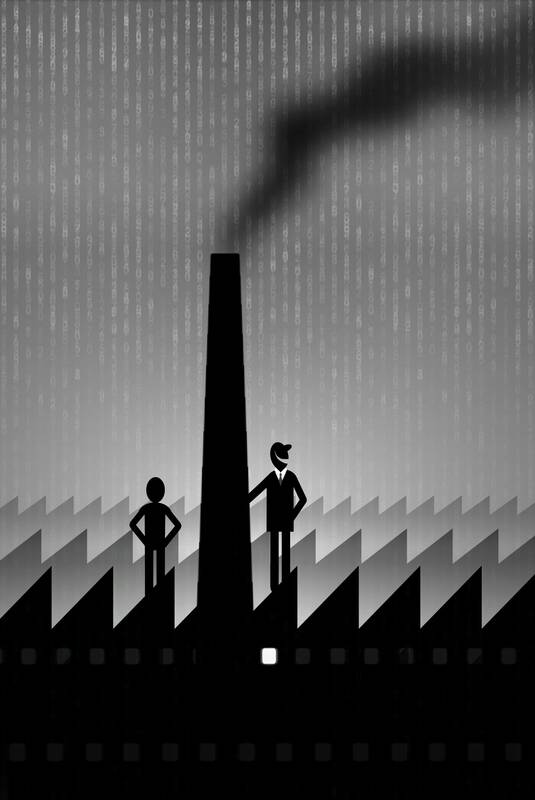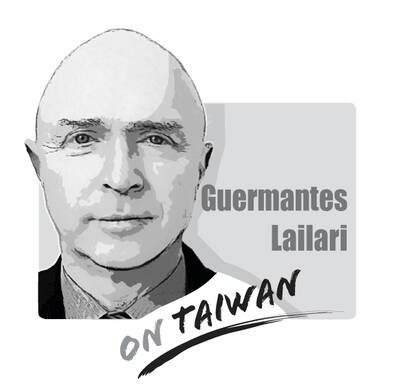Just southeast of Johannesburg, in a South African region known as the Vaal Triangle, 1.7 million people are living in a crossfire of some of the most dangerous pollution on Earth.
From the highway into Vanderbijlpark, you can see the heavy veil of smoke that cloaks Africa’s biggest steel mill. To the southeast, near the town of Vereeniging, the Lethabo Power Station, whose name means “happiness,” joylessly belches out ash and toxic sulfur dioxide. Further south, outside a petrochemicals plant in Sasolburg, an adjacent neighborhood regularly reeks of rotten eggs from hydrogen sulfide in the air.
The plants offer steady work for residents at a time when one in three South Africans is unemployed, yet they are also pumping out harmful emissions at levels so high that Vereeniging is, by some measures, the most polluted city in the world.

Illustration: Yusha
The toxins are causing hundreds of premature deaths every year across the Vaal Triangle and respiratory disease for many of those still breathing. The situation is a stark reminder of the toll the world’s dependency on steel, oil and coal is having on human health and the difficulty a green transition faces if it costs the livelihood of the workers who depend on old-economy jobs.
Vereeniging is relatively unknown outside of South Africa, but the country owes much of its status as the “most industrialized nation on the continent” to it. It was the site of the country’s first coal discovery in 1878, which helped industrialists Sammy Marks and Hendrik van der Bijl establish one of South Africa’s most concentrated industrial areas.
At the town’s Vaal Teknorama Museum, the last lump of coal extracted from the Cornelia mine sits on a desk. A 1923 painting shows a happy image of the local Vaal River, with leisure boats sailing down a watercourse lined with steel mills and power plants.
Coal has ensured industrialization and economic growth in the area, a plaque proclaims.
Today, it has a darker claim to fame.
Vereeniging regularly registers the highest concentration of microscopic emissions known as PM2.5, Bloomberg Green’s analysis of data from OpenAQ — an environmental nonprofit monitoring particulate pollution — showed. The often invisible particulates travel deep into the lungs, which could lead to cancer and cardiac problems.
In the Vaal Triangle, many of them are emitted from industrial plants, which means they often include heavy metals and other toxins that are far more harmful than ordinary dust, South African air quality consultant Ranajit Sahu said.
The problem has been on the South African government’s radar for decades.
In the mid-2000s, it declared the area as the Vaal Triangle Airshed Priority Area, the first zone in which it would make a concentrated effort to lower air pollution. However, the air quality has hardly improved as companies have applied for, and received, exemptions to emission limits and dysfunctional municipalities have stopped collecting waste, forcing residents to burn it. Traffic on the highways crisscrossing the region only adds to the pollution.
Power utility Eskom Holdings SOC Ltd and petrochemicals company Sasol Ltd have repeatedly said they cannot afford or do not have the space to install the equipment required by law to reduce sulfur dioxide pollution. In the past, ArcelorMittal SA has threatened to shut down the formerly state-owned steel mill. They have also repeatedly urged the government to consider the impact of tighter and more expensive pollution standards on their operations in a country with one of the world’s highest unemployment rates.
This resistance may soon be futile. The environment ministry, under new leadership, has signaled that it expects the companies to comply with tougher pollution limits set to come into effect in 2025. ArcelorMittal and the government have also been sued by activists who previously won a ruling that the state was breaching the constitutional right to clean air in nearby Mpumalanga.
No settlement in the area has had to make a bigger sacrifice for South Africa’s economic gains than the township of Sharpeville, close to Eskom’s Lethabo power plant.
The facility burns low-quality coal, meaning more pollution is produced per unit of energy generated.
Two-hundred-and-four premature deaths a year could be attributed to the Lethabo plant, a 2017 study by UK-based air pollution expert Mike Holland showed. This was one of the first studies to detail the scale of power plant pollution in South Africa. It has since been challenged by Eskom, which said its own research has found that it kills about 330 people annually across all of its plants.
Lethabo exceeded emission limits for particulate matter, sulfur dioxide and nitrogen oxides 620 times between April 2016 and December 2017, more than any of the other 14 Eskom plants, a separate study by Sahu showed.
Portia Mofokeng, 35, is one of the residents who live within breathing distance of Lethabo. She developed asthma in 2013 and blames her condition and regular visits to the hospital on industrial pollution. Mofokeng can see the cooling towers of the plant from her corrugated steel shack in Mooidraai, a field that once belonged to a local farm.
“The doctor told me if I want to get healed, I must move from here, go to maybe where there’s no pollution, but I have nowhere to go,” she said, sitting on a cloth-covered chair clutching two inhalers, which cost around a few dollars each. She often has to buy the medication herself out of a US$18 monthly welfare check.
When she applied for work as a safety warden at Lethabo she was told her condition precluded her from getting the job.
The industries that make her ill are seen by her community as the only sure source of jobs in the region. That means there is little opposition from the community.
“Their brothers, their cousins work there, so what’s going to happen?” she asked.
Nearby is Zamdela, an impoverished township that abuts Sasol’s Sigma Colliery and its Sasolburg petrochemicals plant. If you run your hand down the staircase railings of a largely abandoned block of apartments, your hand comes away black with coal dust.
It monitors dust at its “fence line,” the company says.
In a small brick house, Kido Mafisi, who has lived in Zamdela since the late 1970s, displays her medication and said she often awakens to find black and gray dust on her window ledges.
“I can’t breathe,” she said. “I have asthma, bronchitis and skin rashes.”
Progress has been made on air quality in the Vaal Triangle, South Africa’s environmental department said, noting that big companies such as Sasol, ArcelorMittal and Eskom have taken some steps to curb their emissions.
It slashed particulate emissions by 87 percent since 2007 by suppressing dust and replacing old coal-burning equipment, ArcelorMittal said. It has also reduced other pollutants.
Meanwhile, particulate emissions have been cut by 75 percent since 2000 by the installation of electrostatic precipitators — devices that attract dust to electrically charged plates — Sasol said.
In contrast, Eskom’s particulate emissions are at a 31-year high. The pollution is exacerbated by the fact that sulfur dioxide, emitted as a gas, often oxidizes with water vapor to form sulfuric acid particles.
The company runs an offset program that mitigates its particulate matter emissions by removing communal waste that would have otherwise been burnt, Sasol said. Eskom is considering a similar program.
Still, there is little evidence of waste collection.
Across the road from Sasol’s plant, pigs and goats pick through rubbish dumped on the open ground adjacent to rows of small government-built brick houses and tin shacks.
Residents regularly burn refuse as it is no longer cleared by the municipality, waste collector Bernard Mafata said. He drags his trolley between the informal dumps and recycling centers.
Its offset projects equate to preventing the emission of 40 metric tonnes of particulate emissions annually, or 0.5 percent of its annual production of pollutants, Sasol said, stressing that the program is not designed to result in “like-for-like” mitigation.
In an area of the world as polluted as the Vaal Triangle, it could be difficult to see any positive changes on the horizon. However, there are some faint signals.
On top of the government’s new emission limits next year, there is growing international pressure for companies across South Africa to clean up their operations.
Some of the world’s richest nations are funding a US$9.3 billion plan to help South Africa transition away from coal.
The Lethabo plant, which is due to start closing down in 2036, might follow the path of older Eskom facilities. These are slated to be converted to facilities for renewable energy and other activities through the incentive program.
Sasol is also operating a pilot green hydrogen facility in Sasolburg, a fact that it advertises on a billboard in the city.
If these developments succeed, they will aid the battle against the long-term threat of climate change. However, they would not help the people who are inhaling coal’s nasty legacy now.
For residents living in the mess left by South Africa’s industrial giants, patience is running thin.
“We’d like to get compensation. They must pay for us,” Mofokeng said. “They are causing the problem.”
With assistance from Eric Roston and Brian Kahn.
Chinese actor Alan Yu (于朦朧) died after allegedly falling from a building in Beijing on Sept. 11. The actor’s mysterious death was tightly censored on Chinese social media, with discussions and doubts about the incident quickly erased. Even Hong Kong artist Daniel Chan’s (陳曉東) post questioning the truth about the case was automatically deleted, sparking concern among overseas Chinese-speaking communities about the dark culture and severe censorship in China’s entertainment industry. Yu had been under house arrest for days, and forced to drink with the rich and powerful before he died, reports said. He lost his life in this vicious
A recent trio of opinion articles in this newspaper reflects the growing anxiety surrounding Washington’s reported request for Taiwan to shift up to 50 percent of its semiconductor production abroad — a process likely to take 10 years, even under the most serious and coordinated effort. Simon H. Tang (湯先鈍) issued a sharp warning (“US trade threatens silicon shield,” Oct. 4, page 8), calling the move a threat to Taiwan’s “silicon shield,” which he argues deters aggression by making Taiwan indispensable. On the same day, Hsiao Hsi-huei (蕭錫惠) (“Responding to US semiconductor policy shift,” Oct. 4, page 8) focused on

George Santayana wrote: “Those who cannot remember the past are condemned to repeat it.” This article will help readers avoid repeating mistakes by examining four examples from the civil war between the Chinese Communist Party (CCP) forces and the Republic of China (ROC) forces that involved two city sieges and two island invasions. The city sieges compared are Changchun (May to October 1948) and Beiping (November 1948 to January 1949, renamed Beijing after its capture), and attempts to invade Kinmen (October 1949) and Hainan (April 1950). Comparing and contrasting these examples, we can learn how Taiwan may prevent a war with
In South Korea, the medical cosmetic industry is fiercely competitive and prices are low, attracting beauty enthusiasts from Taiwan. However, basic medical risks are often overlooked. While sharing a meal with friends recently, I heard one mention that his daughter would be going to South Korea for a cosmetic skincare procedure. I felt a twinge of unease at the time, but seeing as it was just a casual conversation among friends, I simply reminded him to prioritize safety. I never thought that, not long after, I would actually encounter a patient in my clinic with a similar situation. She had